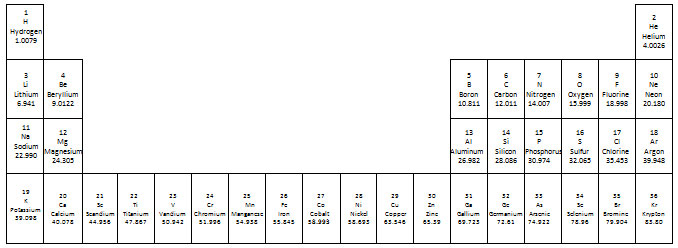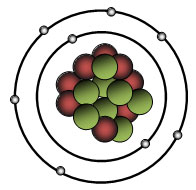
In order to determine the number of protons, neutrons, and electrons, we have to look at the periodic table of elements. Below is a partial periodic table. Click here to view a complete periodic table (scroll down to the second page).

Let's look closely at the information found on the table for the element beryllium. Different periodic tables might have a slightly different way of displaying the information about the elements, but all periodic tables have the following information. Click on each piece of information to learn more about what it tells us.
So, if we need to determine the number of protons, we simply look at the element's atomic number.
How many protons does beryllium have?
Interactive popup. Assistance may be required. 4
In a stable atom, the number of protons and electrons are always equal. So to determine the number of electrons in an atom, you need to know the number of protons.
How many electrons does beryllium have?
Interactive popup. Assistance may be required. 4
The atomic mass of an atom is the number of protons and neutrons found in the nucleus of an atom. The atomic mass is usually a decimal number. When determining the number of neutrons, round the atomic mass to the nearest whole number. For example, the atomic mass of beryllium is 9.0112 so you would round that to 9.
To calculate the number of neutrons, take the atomic mass, which is the number of protons and neutrons, and subtract the atomic number, which is the number of protons in an atom. The result is the number of neutrons.

How many neutrons does an atom of beryllium have?
Interactive popup. Assistance may be required. 5
Let's try another example. Below is the periodic table entry for sodium. Determine the number of protons, neutrons, and electrons.
Given a drawing of an element as seen below, would you be able to identify the element and the number of protons, neutrons, and electrons?

At first glance you might think, "No, I cannot identify the element because I do not know if the red or green circles are the protons or neutrons, and they are overlapping so I cannot count them."
If you think carefully, you can figure it out. It is easy to identify and count the number of electrons. There are 8 electrons total. If there are 8 electrons, then there are 8 protons. Eight protons means the atomic number is 8. You can then look on the periodic table to identify the element.
What is the element?
Interactive popup. Assistance may be required. Oxygen